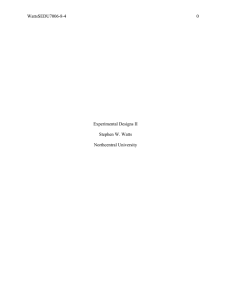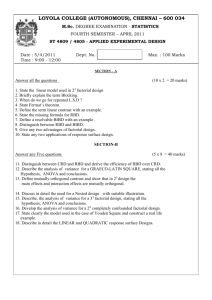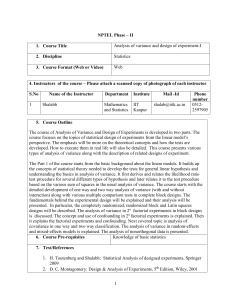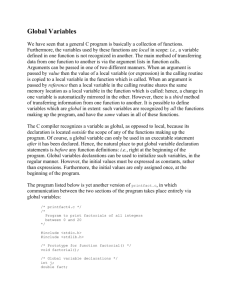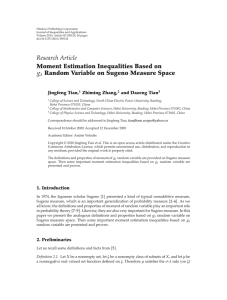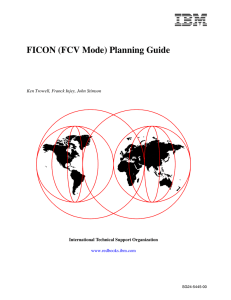this form must be completely filled in
advertisement
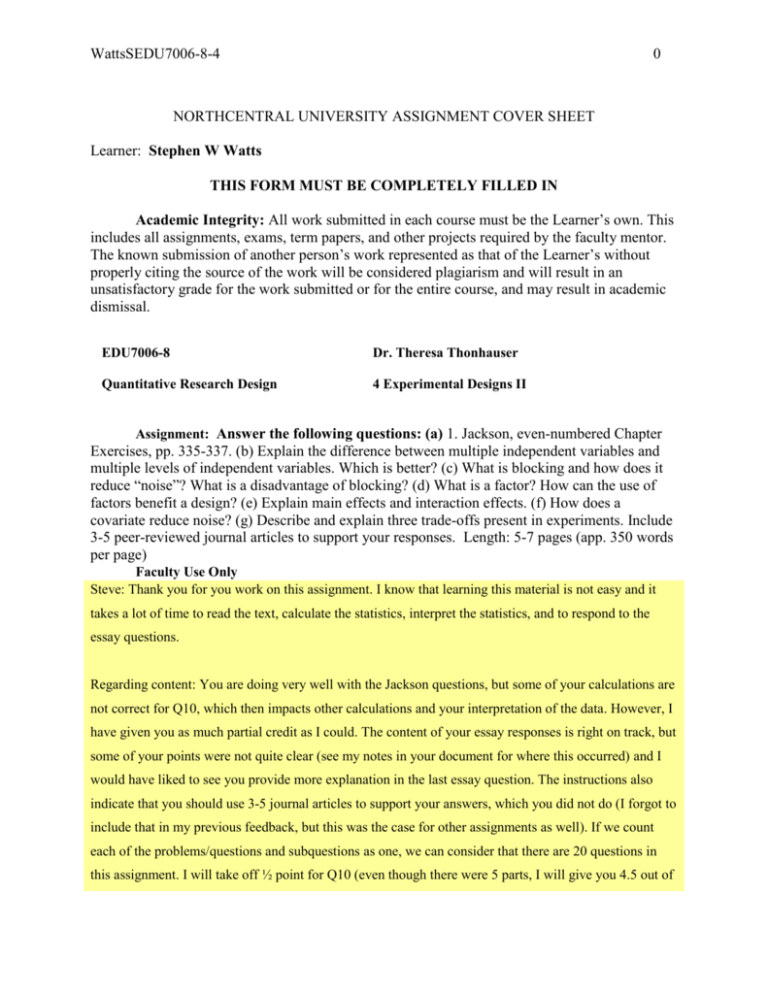
WattsSEDU7006-8-4 0 NORTHCENTRAL UNIVERSITY ASSIGNMENT COVER SHEET Learner: Stephen W Watts THIS FORM MUST BE COMPLETELY FILLED IN Academic Integrity: All work submitted in each course must be the Learner’s own. This includes all assignments, exams, term papers, and other projects required by the faculty mentor. The known submission of another person’s work represented as that of the Learner’s without properly citing the source of the work will be considered plagiarism and will result in an unsatisfactory grade for the work submitted or for the entire course, and may result in academic dismissal. EDU7006-8 Dr. Theresa Thonhauser Quantitative Research Design 4 Experimental Designs II Assignment: Answer the following questions: (a) 1. Jackson, even-numbered Chapter Exercises, pp. 335-337. (b) Explain the difference between multiple independent variables and multiple levels of independent variables. Which is better? (c) What is blocking and how does it reduce “noise”? What is a disadvantage of blocking? (d) What is a factor? How can the use of factors benefit a design? (e) Explain main effects and interaction effects. (f) How does a covariate reduce noise? (g) Describe and explain three trade-offs present in experiments. Include 3-5 peer-reviewed journal articles to support your responses. Length: 5-7 pages (app. 350 words per page) Faculty Use Only Steve: Thank you for you work on this assignment. I know that learning this material is not easy and it takes a lot of time to read the text, calculate the statistics, interpret the statistics, and to respond to the essay questions. Regarding content: You are doing very well with the Jackson questions, but some of your calculations are not correct for Q10, which then impacts other calculations and your interpretation of the data. However, I have given you as much partial credit as I could. The content of your essay responses is right on track, but some of your points were not quite clear (see my notes in your document for where this occurred) and I would have liked to see you provide more explanation in the last essay question. The instructions also indicate that you should use 3-5 journal articles to support your answers, which you did not do (I forgot to include that in my previous feedback, but this was the case for other assignments as well). If we count each of the problems/questions and subquestions as one, we can consider that there are 20 questions in this assignment. I will take off ½ point for Q10 (even though there were 5 parts, I will give you 4.5 out of 5 on that question), ½ point for Q19, and ½ point for not including journal articles so your content score would be: 18.5 out of 20, which would be 92.5%. Regarding writing: I tried to give you more writing feedback in this paper so that you would see why I give the writing scores that I do. I will give you a 93% for writing here, which is the highest that I think I can give based on the issues and inconsistencies that I see in your writing. Please see my comments and edits throughout your document for details on writing issues in this paper. I hope that you are not discouraged by my evaluation of this assignment. Graduate work should be very challenging and, based on what I see in your work, I think you are up for the challenge and have the capacity to improve your work. Please note that individual faculty mentors do not have the ability to design or change the course or syllabus. Courses are designed and updated by a team of core faculty members and instructional designers. I encourage you to provide comments and suggestions about the syllabus and the course in the post-course survey if you feel that instructions are not matching instructor expectations in these courses. Thanks! Theresa Thonhauser Content Score: 92.5% Writing Score: 93% July 24, 2012 Running head: WattsSEDU7006-8-4 2 Experimental Designs II Stephen W. Watts Northcentral University WattsSEDU7006-8-4 3 Experimental Designs II Jackson (2012) Chapter Exercises #2. A 4 x 6 factorial design has two independent variables; the first with four levels and the second with six. A 4 x 6 factorial design has 24 conditions. #4. A cell mean represents the average score of participants in a condition, where a specific value of each independent variable interacts. Main effect means represent the average score of participants for a single independent variable, where no interaction with other independent variables are considered. #6. In a complete factorial design comparisons are made between each level of all independent variables with each level of every other independent variable. An incomplete factorial design is considered incomplete because comparisons are not made between each level of all independent variables with each level of every other independent variable; some comparisons are not made (Jackson, 2012). #8. The number associated with the way of the ANOVA identifies the number of independent variables. A two-way ANOVA is an analysis of variance with two independent variables. A three-way ANOVA is an analysis of variance comparing three independent variables. #10. SOURCE Factor A Factor B AxB Error Total df 1 2 2 30 35 SS 60 40 90 200 390 MS 60 F(1, 30) = 20 F(2, 30) = 45 F(2, 30) = 6.667 F 9 Fcv = 3 Fcv = 6.75 Fcv = 0.05 4.17 3.32 3.32 SOURCE Factor A df 2 SS 40 MS 20 F(2, 72) = F 3 Fcv = 0.05 3.15 0.01 7.56 5.39 5.39 0.01 4.98 WattsSEDU7006-8-4 4 Factor B AxB Error Total 3 6 72 83 SOURCE Factor A Factor B AxB Error Total df 1 1 1 36 39 60 150 150 400 SS 10 60 20 60 150 20 F(3, 72) = 25 F(6, 72) = 2.083 3 Fcv = 3.75 Fcv = MS 10 F(1, 36) = 60 F(1, 36) = 20 F(1, 36) = 1.667 F 1.50 Fcv = 9.00 Fcv = 3.00 Fcv = 2.76 2.25 0.05 4.17 4.17 4.17 4.13 3.12 0.01 7.56 7.56 7.56 #10a. For the first study, Factor A, F(1,30) = 9.00, p < .01; Factor B, F(2,30) = 3.00, not significant; Interaction between A x B, F(2,30) = 6.75, p < .01. For the second study, Factor A, F(2,72) = 3.00 not significant; Factor B, F(3, 72) = 3.00, p < .05; Interaction between A x B, F(6.72) = 3.75, p < .01. For the third study, Factor A, F(1, 36) = 1.50 not significant; Factor B, F(1,36) = 9.00, p < .01; Interaction between A x B, F(1,36) = 3.00 not significant. #10b. The first study is a 2 x 3 factorial design and has six conditions. The second study is a 3 x 4 factorial design and has 12 conditions. The third study is a 2 x 2 factorial design and has four conditions. #10c. In the first study there were 36 participants in the six conditions. In the second study there were 84 participants in the 12 conditions. In the third study there were 40 participants in the four conditions. #10d. In the first study, factor A was the only significant main effect accounting for approximately 15% of the variance, while there was also a significant interaction effect between factor A and B accounting for approximately 23% of the variance, both at the p < .01 level. In the second study, the only significant main effect was factor B, accounting for approximately 15% of the variance at the p < .05 level, while the interaction effect between factors A and B WattsSEDU7006-8-4 5 accounting for approximately 37.5% of the variance, is significant at the p < .01 level. In the third study there is no significant interaction effect between factors A and B and the only significant main effect was factor B, accounting for approximately 40% of the variance at the p < .01 level. #12a. SOURCE Factor A - gender Factor B - time AxB Error Total df 1 2 2 24 29 SS 0.027 140.600 0.073 28.000 168.700 MS 0.027 F(1, 24) = 70.3 F(2, 24) = 0.0365 F(2, 24) = 1.167 F 0.023 Fcv = 60.257 Fcv = 0.031 Fcv = 0.05 4.26 3.40 3.40 #12b. Gender, F(1,24) = .02, not significant; Practice, F(2,24) = 60.26, p < .01; Gender x Time, F(2,24) = .03, not significant. #12c. Gender and the interaction of gender and practice time do not affect reaction time, but the main effect of practice time significantly affects reaction time. #12d. The effect size (η2) is 0.833, meaning that approximately 83% of the variance regarding reaction time is attributable to the amount of practice time. 14 12 10 Women's Reaction Time (sec) 8 6 Men's Reaction Time (sec) 4 2 0 #12e. 2 hours Assignment Question Answers 4 hours 6 hours 0.01 7.82 5.61 5.61 WattsSEDU7006-8-4 6 Explain the difference between multiple independent variables and multiple levels of independent variables. Which is better? Multiple independent variables allow the researcher to conduct more complicated experiments; manipulating multiple variables and determining the effect of each independently as well as the interaction between each variable. Multiple levels of independent variables allow the researcher to assess each independent variable more completely with multiple treatments or conditions. These operations are not mutually exclusive. An experiment with multiple independent variables could have one or more independent variables with multiple levels. Both multiple independent variables and multiple levels of independent variables allow the researcher to get more information from a single experiment while keeping the number of participants low. Whether one is better than the other depends on what the researcher is attempting to discover from the study. If the researcher is seeking to better understand the behavior of a single factor then a multiple level independent variable is better. If the researcher believes that a behavior is caused by several factors, or the interaction between those factors, then a multiple independent variable design is better. What is blocking and how does it reduce “noise”? What is a disadvantage of blocking? Blocking is a technique whereby subjects are divided into “relatively homogeneous subgroups” (Trochim & Donnelly, 2008, p. 198). Noise consists of the extraneous factors that can make it difficult to determine effects in the real world. Blocking reduces noise and strengthens the treatment effect by minimizing the variability between subjects in each block. The disadvantage of blocking is that if, after the division, the subgroups are not homogeneous; variability increases, decreasing the ability of the researcher to determine effect. What is a factor? How can the use of factors benefit a design? A factor is a variable. By using more than one independent variable in a design, researchers are able to determine the WattsSEDU7006-8-4 7 effect of each independent variable, known as a main effect, as well as the effects of the interactions between the variables, or interaction effects. Using a factorial design enables the investigator to conduct research that mirrors the real world more accurately than what? Explain main effects and interaction effects. Main effects depict the consequences of a single independent variable in isolation from other independent variables in a factorial design. Interaction effects depict the results of the combining of two or more independent variables. In these interactions, the researcher may determine what outcomes are attributable to each variable at various levels of other variables. How does a covariate reduce noise? A covariate is a variable that is adjusted in a study so as to remove its affect on the independent variable. This adjustment is done statistically. By removing the affect of the covariate, the effect of the independent variable remains, but the variability due to the covariate is removed, resulting “in a more efficient and more powerful estimate of the treatment effect” (Trochim & Donnelly, 2008, p. 201). Describe and explain three trade-offs present in experiments. The one constant of experiments is the use of randomization to assign subjects to condition groups (Wiley, 2009). All other decisions with regards to design involve trade-offs; selecting one design has both advantages and disadvantages. Once a design is determined, the appropriate statistical analysis is chosen. This analysis is conducted following the collection of data. The largest trade-off of an experiment regards internal versus external validity. An experiment is about control. The purpose of an experiment is to keep all conditions equivalent except for the manipulation of the independent variable. This does not necessarily work well in the real-world. If the researcher succeeds in this control, the internal validity of the experiment is very high and cause and effect WattsSEDU7006-8-4 8 can be?? determined, while external validity may be very low since the results may not be generalizable outside of the experimental conditions. The number of participants available for a study poses a trade-off to the research designer. A simple design will generally require fewer participants than will a more complex design, but complex designs are able to determine interactions and effects that are more consistent with the real-world, increasing external validity while maintaining internal validity. Wiley (2009) acknowledged three trade-offs regarding sample size; (a) larger sample sizes allow for discovering small effects but increase time and expense, (b) larger sample sizes, in a highly human interactive experiment, may increase more variability than the effects discovered, and (c) larger sized samples are less likely to show?? large differences between groups, but are unlikely to eliminate all differences between groups???. Wiley (2009) identified a potential trade-off in experiments using blocking. Blocking’s advantages are its ability to test secondary hypotheses, obtain “repeated measures of each experimental unit or subject” (p. 447), and reduce noise in the results. Blocking’s disadvantages are that it results in a “lower sample size . . . for testing the primary hypothesis” (p. 447) and diminishes the ability to generalize results. These are descriptions of some of the trade offs we encounter when we conduct experiments, but I would have liked to see some explanation or examples here regarding those trade offs. For example, what do you think about some of these issues? Do you think we should try to achieve internal or external validity if we have to make a choice between the two? Do you think the advantages of Blocking outweigh the disadvantages? Why do you think some of these trade offs occur? How important are they? You could have used some peer-reviewed articles here to support or illustrate your explanation. WattsSEDU7006-8-4 9 References Jackson, S. L. (2012). Research methods and statistics: A critical thinking approach (4th ed.). Belmont, CA: Wadsworth Cengage Learning. Trochim, W. M. K., & Donnelly, J. P. (2008). The research methods knowledge base (3rd ed.). Mason, OH: Cengage Learning. Wiley, R. H. (2009). Trade-offs in the design of experiments. Journal of Comparative Psychology, 123(4), 447-449. doi:10.1037/a0016094
